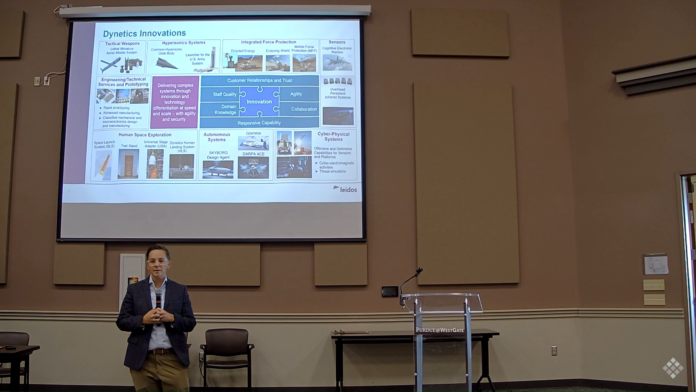Carol Johnson, Southern Indiana Business Report
ODON – The United States was a leading innovator in hypersonics for 75 years, but canceled programs and funding cuts slowed the program’s technology advances. In the last decade other countries have developed hypersonics programs, leading the US to re-invest in hypersonics.
A new program to accelerate the testing of hypersonic components aims to bring the US back to the forefront of hypersonics. Naval Surface Warfare Center Crane, home to the Joint Hypersonics Transition Office (JHTO) Systems Engineering Field Activity, is part of that effort.
The Multi-Service Advanced Capability Hypersonic Test Bed (MACH-TB) program will accelerate the testing of commercial hypersonic components. The MACH-TB includes producing an experimental glide body to measure and verify hypersonic component data.
The contract for the MACH-TB tests was awarded in 2022 to Leidos by the Naval Surface Warfare Center Crane under the NSTXL Strategic and Spectrum Missions Advanced Resilient Trusted Systems (S2MARTS) OTA.
Earlier this month, Ashley Brawner, director of advanced programs and initiatives at Leidos, was a guest speaker at the Purdue@WestGate First Tuesday; event sponsor was Wininger Construction.
In her role at Leidos, Brawner leads key stakeholder engagements, strategic initiatives and technology innovation to enable current and future weapon systems. She previously served as the inaugural Senior Program Manager of the MACH-TB program, playing a critical role in acquiring the new program for Naval Surface Warfare Center-Crane for Leidos.
In this role she led the large and diverse industry, academia and national laboratory team to increase flight test opportunities for hypersonic technology maturation resulting in the first hypersonic technology flight test utilizing a commercial space launch provider within 49 days of contract award.
Brawner spoke about ways Leidos is leading the tech world with its innovations in hypersonics and microelectronics for the US Army and US Navy. Much of this work is within Dynetics, which is the applied research and technology accelerator for Leidos.
“We are very excited about the MACH-TB program,” Brawner said. “It’s about testing those early technologies for transition into flight vehicles. It’s no shock it takes a long time to get technologies ready for fielding.”
Hypersonics overview
Hypersonic speed is defined as five times the speed of sound. Hypersonic missiles are launched one of three ways: from the air via aircraft in flight, from the ground via fixed or vehicle-based launchers and from the sea, via surface ships or submarines.
There are three types of hypersonic missiles.
- Intercontinental ballistic missiles, which have been around since the 1970s. ICBMs have a traditional ballistic missile trajectory making them easier to detect for our adversaries.
- Hypersonic cruise missiles, also known as air-breathing missiles, which are scramjet powered, maneuver within the atmosphere and fly toward targets at hypersonic speeds.
- Hypersonic glide vehicles, which are rocket-boosted to a point where the glide vehicle is released and then continues to glide through the atmosphere to the target.
Glide vehicles are the latest phase in hypersonics innovation.
“One of the arguments going forward is how we augment all these systems so they provide the warfighter the best benefit in the event of a conflict,” she said.
MACH-TB will accelerate the traditional testing timeline, which she said is game changing.
“We’re talking about speeding up the technology from seven to 10 years to two to three years,” she said.
Having an affordable opportunity for flight testing in a hypersonic environment is “game changing,” she said.
MACH-TB will be led by an integrated team.
“We’ve been able to bring the best in class, different types of flight test opportunities for hypersonics,” she said.
Brawner said Crane’s role in advancing the US hypersonics program is to be lauded.
“What is really exciting about the MACH-TB program is it’s directly in support of one of our national initiatives,” Brawner said. “Hypersonics is one of the top critical technologies that needs to be delivered to the warfighter.
“It’s really a great thing what Crane has been able to do here to highlight the ways in which we can think creatively because flight test infrastructure and flight test opportunities are critical to delivery of warfighting systems.”



